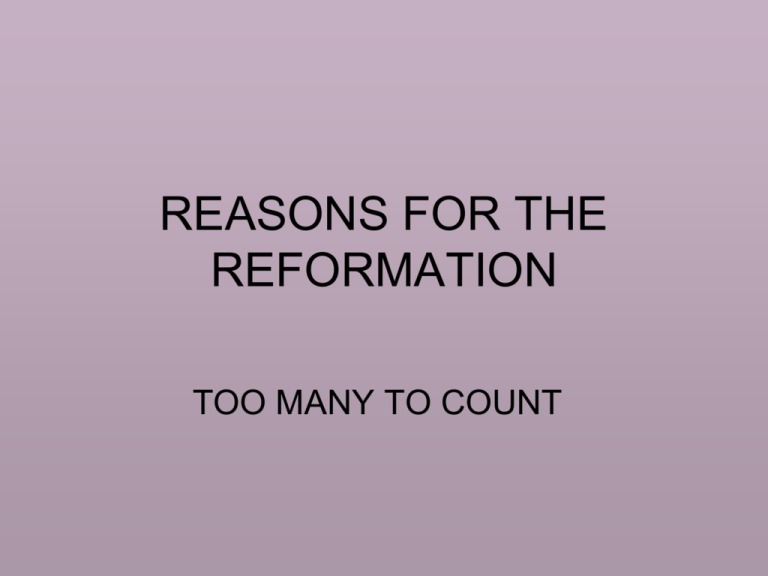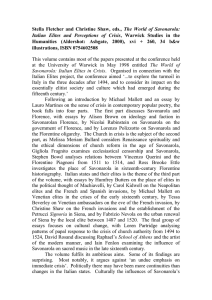reason for the reformation
advertisement

REASONS FOR THE REFORMATION TOO MANY TO COUNT THE RELIGIOUS SITUATION ABOUT 1560 By 1560, Luther, Zwingli, and Loyola were dead, Calvin was near the end of his life, the English break from Rome was complete, and the last session of the Council of Trent was about to assemble. This map shows “religious geography” of western Europe at the time. DECLINE OF THE PAPACY – Damaged by Babylonian Captivity (1309-1378) and Great Schism (1378-1417) – Renaissance Popes often more interested in the arts than the spiritual welfare of the people – Popes and high church officials often lived in great luxury – Monarchs considered the popes rivals for political power – often fought battles to protect Papal States – Conciliar Movement had encouraged a diffusion of power CORRUPTION IN THE CHURCH • Lower clergy poorly educated, lack knowledge of Church doctrine • Breaking of clerical vows: poverty, chastity, and obedience not followed • Simony: selling of Church offices • Sale of indulgences: forgiveness of punishment in Purgatory sold to sinners CORRUPTION IN THE CHURCH • Excessive money collection: tithes, clerical fees, support of the monasteries, bishops, etc. Peter’s Pence: money collected to support popes • Absenteeism: bishops and cardinals were often absent from their area of responsibility, leaving the governing of the territory to subordinates • Pluralism: some prelates held multiple offices, reaping the economic benefits from all of them DEMAND FOR REFORM • John Wycliffe (1328-1384): English theologian and reformer who taught at Oxford University. He said the Bible was the highest source of truth, preached against the wealth and worldliness of the Church; he denied transubstantiation, he advocated a vernacular Bible. After his death he was condemned by the Council of Constance (1415) and his body was ordered exhumed and burned. Wycliffe’s ideas were taken up and disseminated in England by the Poor Preachers and later by the Lollards DEMAND FOR REFORM • John Huss (1372-1415) Bohemian reformer and follower of Wycliffe. He criticized the church’s wealth and corruption and opposed the condemnation of Wycliffe’s doctrine. He was forbidden to preach, was excommunicated. In 1413 he published “On the Totality of the Church”. He urged a return to the values of early Christianity. DEMAND FOR REFORM • Assured safe conduct by the Holy Roman Emperor, Sigismund, he traveled to the Council of Constance. He was arrested within a month and condemned for heresy, he was burned at the stake. After his execution, Huss’ teachings and works became the rallying point for Czech national self-expression. His followers were called Hussites DEMAND FOR REFORM • Savonarola (1452-1498) Dominican Friar who attempted to establish a theocratic government in Florence. DEMAND FOR REFORM • He became prior of San Marco in Florence in 1490 at the insistence of Lorenzo de Medici. The sermons that he preached were marked by the theme of warning against coming doom. His sermons became more popular and more pointed, with directed attacks on the vices and tyrannical abuses of the Medici government DEMAND FOR REFORM • When French intervention allowed (1494) the Florentines to expel the Medici and establish a republic, Savonarola became virtual dictator in the city, imposing a program of sweeping moral reforms. He began the practice called the “Bonfire of the Vanities” – burning of wigs, velvet gowns, rare manuscripts, paintings. DEMAND FOR REFORM • He interpreted the French intervention as the vengeance and punishment he had prophesied earlier. He also began to see himself as a prophet of God sent to announce judgment on Italy and on the church. Soon his ties with the French brought him into conflict with Pope Alexander VI, who was desperately forming alliances against the French. DEMAND FOR REFORM Savonarola • In 1495, Savonarola ignored a summons to Rome to explain his supposed revelations from God. The pope, pressured by the Florentine partly opposed to Savonarola, then initiated an inquiry and suspended him from preaching until the case was settled. Savonarola at first complied and a truce was arranged between the two so long as Savonarola avoided politics in his sermons – an impossible condition. DEMAND FOR REFORM • In the final clash between the two, Alexander excommunicated Savonarola, but when his censure was published in Florence, Savonarola denied its validity. Soon his intransigence and defiance alienated his supporters in the Florentine government. When popular feeling turned against him, he was arrested, tortured, tried, and condemned to death for heresy and schism. He was hanged and burned. DEMAND FOR REFORM • Desiderius Erasmus (14661536) Dutch humanist who advocated peace, reconciliation, and unity as a cure for the disintegration of medieval Europe into disputatious national and religious factions. His works combined piety and scholarship in an attempt to reconcile faith and reason and bring together Christianity and culture of ancient times. He was sharply critical of the corruptions of the church but did not reject basic dogma. DEMAND FOR REFORM • His attempt to reform the church through gentle reason and toleration was swept aside by the fanaticism of the Reformation and Counter Reformation. He wrote In Praise of Folly while staying in England with his friend Sir Thomas More. In it he attacked the superstition, vulgarity, and foolishness of his day. Erasmus pursued a career of writing and traveling that took him to most countries of Europe and won him the friendship of many leading humanist scholars of his time. DEMAND FOR REFORM • Sir Thomas More (1478-1535) English Christian humanist and statesman. He was educated at Oxford and at Lincoln’s Inn, where he studied law. As speaker of the House of Commons in 1523, More helped establish the parliamentary privilege of free speech. He refused to endorse King Henry VIII’ plan to divorce Catherine of Aragon. Nevertheless, after the fall of Thomas Wolsey, More became Lord Chancellor. DEMAND FOR REFORM • His work in the law courts was exemplary, but he resigned in 1532, citing ill health and probably feeling that he could not in conscience serve a government that was interfering with the church. Two years later he was imprisoned in the Tower of London for refusing to acknowledge Henry as supreme head of the Church of England. He was found guilty of treason, on evidence that was probably perjured and was beheaded on July 6, 1535. More was canonized in 1935. NEW TECHNOLOGY • Paper: Expensive parchment (sheepskin) and medium (calfskin) was replaced by Arab technique of making paper from shredded rags; greatly reduced price • Printing Press: Movable Type: Invented in China by Pi Sheng in 11th century. Johann Gutenberg used a printing press, printed the Bible in ~1453 in Mainz, Germany NEW TECHNOLOGY - EFFECTS • Reduced the price of books so that they became more available and more Europeans could buy them • Religious critics spread their ideas more easily • Illustrated religious books encouraged popular piety. • Bible available to all literate Christians – no longer dependent on priest to interpret for them MARTIN LUTHER AND PARENTS




